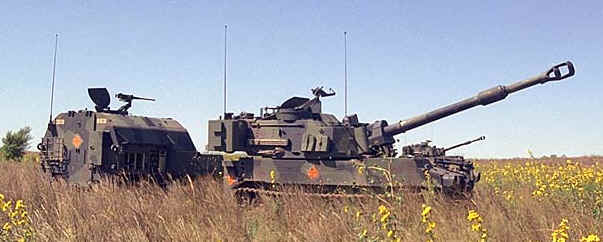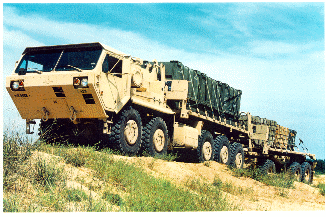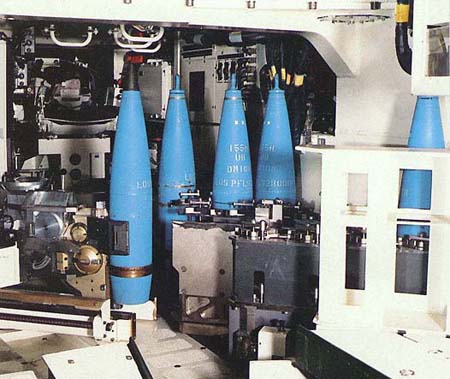One of the most ignored problems facing a modern army is supplying artillery ammunition to mobile forces. Since World War II, newer artillery guns have increased rates of fire and use larger calibers of ammunition. This new burden was not recognized during the Cold War since artillery ammunition was simply stored where needed for defense. However, expeditionary operations require the movement of ammunition from ships to the battlefield. In the US Army, each 155mm gun is expected to fire an average of 205 rounds a day. This means that each heavy "armored" division with 54 155mm guns needs 11,070 rounds a day, or 554 tons of 155mm ammo a day, which requires 111 5-ton truck deliveries EACH DAY. This amount was never available during the 1991 Gulf War and artillery units were constrained to firing at battalion-size targets due to a lack of ammo, AFTER SIX MONTHS OF LOGISTICAL BUILD-UP! And of course this is just ammo, fuel for these trucks and the huge self-propelled artillery guns is required, plus food and other support.

The reason modern artillery can't keep up with mobile forces is not the problem of moving the guns, but moving the ammo. A major problem is the way munitions are safely and economically packed for shipment. Unpacking artillery rounds, bag charges, and fuzes is manpower intensive. A 155mm Paladin howitzer with 40 rounds, supported by its M992 FAASV resupply buddy (above) with 60 rounds, can fire those 100 rounds in 25 minutes. The Army says a FAASV supply vehicle can be reloaded in 15 minutes, but by whom? If a battery is lucky, a column of trucks loaded with 155mm rounds is following behind. How many HOURS does it take them to offload, unpack and reload several FAASVs?
Resupply is where the artillery units collide with the logisticians. The supply system wants trucks carrying a load forward, followed by immediate unloading and return for another trip, because a heavy division needs 111 truck loads a day delivered. This results in the creation of huge ammo dumps scattered over the battlefield. If tactical movement becomes necessary, the artillery unit drives away and leaves these dumps behind. The alternate method is to use supply trucks as rolling magazines following tactical units around the battlefield. Artillery battalions love this approach, but it's the last thing division and corps supply officers want for obvious reasons. This problem is magnified because enemy counterbattery radar can instantly locate a firing battery. Therefore, tactical doctrine for an artillery battery is to "shoot and scoot" i.e. move to another location immediately after firing a volley. While this is possible for self-propelled artillery under armor, it doesn't explain what the gaggle of supply trucks, forklifts, and pallets of ammo can do to evade destruction.
 This is one reason
the planned 155mm Crusader howitzer system was canceled. The big problem is not range
and rate of fire, but ammo resupply. Planning an average of 205 rounds of
day is conservative for high-intensity 24-hour operations, especially when a
M109A6 155mm SP Paladin can fire that many rounds in an hour. Do units need more forklifts,
trucks, tracked supply vehicles, and manpower? If the system can only
provide ammo for two guns per battery, why deploy and man six? Perhaps better ways of packaging
ammo should be considered, like a snap-in magazines? Or, should each
Paladin gun have two FAASVs? These ideas were posed to experienced
artillerymen, Larry Altersitz, who provides this detailed insight:
This is one reason
the planned 155mm Crusader howitzer system was canceled. The big problem is not range
and rate of fire, but ammo resupply. Planning an average of 205 rounds of
day is conservative for high-intensity 24-hour operations, especially when a
M109A6 155mm SP Paladin can fire that many rounds in an hour. Do units need more forklifts,
trucks, tracked supply vehicles, and manpower? If the system can only
provide ammo for two guns per battery, why deploy and man six? Perhaps better ways of packaging
ammo should be considered, like a snap-in magazines? Or, should each
Paladin gun have two FAASVs? These ideas were posed to experienced
artillerymen, Larry Altersitz, who provides this detailed insight:
_____________________________
"Modern US/NATO/allied
field artillery is based on two calibers: 105mm for
light artillery and 155mm for medium artillery. The
deep battle roles of interdiction/counter-battery/suppression of enemy air
defense have been taken over by MLRS and ATACMS.
If there was a "Universal" fuze, capable of being set on Delay
(cratering/penetrating action), SuperQuick (standard impact detonation), Low Air
Burst (2-3 meters above ground), Variable Time (for Smoke/Illum/APERS) or
Proximity (air defense) that was loaded on the projectile at the shipping point,
with multiple safeties to prevent premature detonations, you might be able to
reduce some of the handling problems. An
electronic fuze was under development some time ago, but I have no idea of the
current status of the program.
155mm projectiles come in 8-packs: wooden base and top strapped together,
lifted onto the ammunition vehicle by a crane. Powder comes in metal tubes with screw-off ends. Fuzes come separately, as with 105mm rounds. A standard HE 155mm projectile weighs 95 lbs., with the full powder
canister weighing at least 15 lbs. 175mm/203mm
projectiles were moved in 4-packs; the 175mm weighed over 150 lbs and the 203mm
was over 200 lbs. Navy 127mm guns
are also separate loading, but automated.
Since the 105mm is towed, unless it is motorized for the Brigade Combat Teams, the ammo is on the back of the prime mover
vehicle, with re-supply accomplished by trips to Service Battery, or delivery to
a position by Service Battery's Ammo Platoon. 155mm towed howitzers (M198) for both the Army and Marines have the same
situation, but complicated by the increased size and weight of the projectiles
and powder. Self-propelled 155mm
(M109A6 Paladin) howitzers and the new Crusader howitzer have a dedicated
protected (I refuse to call it armored) FAASV (Field Artillery Ammunition Supply
Vehicle) which looks like a howitzer without a moving turret and no gun. The concept is to have the FAASV sit behind the howitzer, with a part of
the gun section preparing rounds and powder in the FAASV, then moving it to the
howitzer on a connecting ramp by a conveyor belt-type mechanism which places the
fuzed projectile and powder increments in the howitzer.
The problems are several as you can see. First, it is labor intensive; second it is bulky; third, there is a limit
on what is available to fire at any given time; fourth re-supply by moving the
FAASV back to the Service Battery ammo point is time consuming, even though
there is equipment to load the FAASV quickly. Fifth, the numbers game with personnel is an Artillery problem, also.
105mm solutions: use something like the rack system that the M1 tank has,
allowing the round to be extracted quickly. It would have to have a downward slant at the canister base, so when a
release was tripped, the round would slide canister first into the cannoneer's
hand. Make the racks of
engineered polymers (plastic), each tube a separate sealable holder.
Make the rack solid on 5 sides to prevent damage, with simple bolts to
fix them onto a vehicle bed or wall mount that can be accessed by a crane. If you could seal the remaining opening with 6-mil plastic film, you
reduce the dunnage problem greatly. Rounds
would be grouped by type: HE, Smoke/WP/Illum, APERS/HEAT/HESH/HEP, in colored
racks. Same system concept for
fuzes, with color codes to identify them as Quick/Time/VT.
Sections could have a "limber" type 1/2 ton trailer that
carried 80 rounds pulled by the prime mover, with the 105mm connected to the
limber. A rack trailer could pick
up empty racks for reloading at an Ammunition Supply Point (ASP), and an ammo
vehicle, like a 5-tn/HEMTT with trailer could be co-located with the battery.
The trailer would be emptied first, then moved back to the ASP for
re-loading. Material handling
equipment (MHE) helps, but it doesn't obviate the need for personnel.
 The 155mm problems are far more intractable. The sheer size and weight of the objects mean MHE is badly needed, but
shipping them to the ASP might be addressed if we use the concept of a protected
container on a HEMTT/PLS system. Use
one for rounds and one for powder/fuzes. Again,
maybe racks might work. If racks
are helicopter-usable for rapid, emergency re-supply, sling-loaded or interior
carried, you still need MHE on the firing position to move the racks.
The 155mm problems are far more intractable. The sheer size and weight of the objects mean MHE is badly needed, but
shipping them to the ASP might be addressed if we use the concept of a protected
container on a HEMTT/PLS system. Use
one for rounds and one for powder/fuzes. Again,
maybe racks might work. If racks
are helicopter-usable for rapid, emergency re-supply, sling-loaded or interior
carried, you still need MHE on the firing position to move the racks.
Reducing the number of tubes per battery is an option, but the loss of a tubes
leave a maneuver battalion with less firepower when really needed.
Maybe reducing the battery to 4 tubes will help with ammo supply without
critically endangering the mission when losses are suffered,
but I would prefer going back to 8 myself. If we did away with mess teams, using on-vehicle (track or wheeled)
heating equipment for MREs or Section tray packs (set up for the number of
people in a section [6, 7 or 8] rather than 10), meals/water could be handled
with normal re-supply. That might
free up some slots for the Ammo Platoon.
The needs for a battery will vary greatly with the situation. Guerilla war would require more overhead protection and towed guns capable of helicopter movement. They tend to be infantry wars. But we don't know the shape of the guerrilla wars of the 21st Century yet. Is it going to be information intensive? With a problem that small groups of guerillas can pack a big wallop? Do we need more light guns? No MLRS? A Kosovo-type might require fewer guns, but more attack helicopter assets, since artillery tends to be a blunt weapon, and the scalpel might be far more necessary. Again, what is the rate of fire per day/per gun set by the highest headquarters? 20? 50? What kind of rounds? Can you squirrel some rounds away for a rainy day situation? How are you going to move all this stuff? The old adage "size does matter" applies here and with size comes weight. Until some other means of propelling projectiles down range with accuracy is developed, we are stuck with powder and shot."
_________________________
Other means of propelling projectiles was developed long ago, as this older G2mil article explains: Pneumatic Guns
©2015 www.G2mil.com